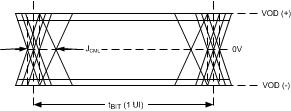SNLS507C September 2016 – December 2022 DS90UB934-Q1
PRODUCTION DATA
- Features
- 1Applications
- 2Description
- 3Revision History
- Pin Configuration and Functions
- 4Specifications
-
5Detailed Description
- 5.1 Overview
- 5.2 Functional Block Diagram
- 5.3 Feature Description
- 5.4 Device Functional Modes
- 5.5 Programming
- 5.6 Register Maps
- 6Application and Implementation
- Mechanical, Packaging, and Orderable Information
- 7Device and Documentation Support
- Mechanical, Packaging, and Orderable Information
Package Options
Mechanical Data (Package|Pins)
- RGZ|48
Thermal pad, mechanical data (Package|Pins)
- RGZ|48
Orderable Information
5.4.5 Channel Monitor Loop-Through Output Driver
The DS90UB934-Q1 includes an internal channel monitor loop-through output on the CMLOUTP/N pins. A buffered loop-through output driver is provided on the CMLOUTP/N for observing jitter after equalization for each of the two RX receive channels. The CMLOUT monitors the post EQ stage, thus providing the recovered input of the deserializer signal. The measured serial data width on the CMLOUT loop-through is the total jitter including the internal driver, AEQ, back channel echo, etc. Each channel also has its own CMLOUT monitor and can be used for debug purposes. This CMLOUT is useful in identifying gross signal conditioning issues. The intrinsic jitter, JCML, represents the amount of jitter seen with a clean serial stream applied to the FPD-Link III input pins. When the total jitter is measured on CMLOUTP and CMLOUTN, the typical intrinsic jitter value can be subtracted to get an approximation of how much jitter is seen at the RIN[1:0]± input pins.
Table 5-6 includes details on selecting the corresponding RX receiver of CMLOUTP/N configuration.
| PARAMETER | TEST CONDITIONS | PIN | MIN | TYP | MAX | UNIT | |
|---|---|---|---|---|---|---|---|
| JCML | CMLOUT Differential Output Intrinsic Jitter | Clean clock fed into FPD-Link III input RL = 100 Ω (Figure 5-4) | CMLOUTP, CMLOUTN | 0.15 | UI(1) | ||
10-bit mode: 1 UI = 1 / ( PCLK_Freq. /2 x 28 )
12-bit HF mode: 1 UI = 1 / ( PCLK_Freq. x 2/3 x 28 )
12-bit LF mode: 1 UI = 1 / ( PCLK_Freq. x 28 )
 Figure 5-4 CMLOUT Output Driver
Figure 5-4 CMLOUT Output Driver| FPD3 RX Port 0 | FPD3 RX Port 1 | |
|---|---|---|
| ENABLE MAIN LOOPTHRU DRIVER | 0xB0 = 0x14 0xB1 = 0x00 0xB2 = 0x80 | 0xB0 = 0x14 0xB1 = 0x00 0xB2 = 0x80 |
| SELECT CHANNEL MUX | 0xB1 = 0x02 0xB2 = 0x20 0xB1 = 0x03 0xB2 = 0x28 0xB1 = 0x04 0xB2 = 0x28 | 0xB1 = 0x02 0xB2 = 0xA0 0xB1 = 0x03 0xB2 = 0x28 0xB1 = 0x04 0xB2 = 0x28 |
| SELECT RX PORT | 0xB0 = 0x18 0xB1 = 0x0F 0xB2 = 0x01 0xB1 = 0x10 0xB2 = 0x02 | 0xB0 = 0x18 0xB1 = 0x0F 0xB2 = 0x01 0xB1 = 0x10 0xB2 = 0x02 |